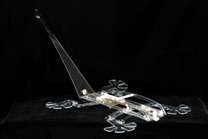When bird meets machine, bioinspired flight

Working at a crossroad between biology and engineering, scientists have modeled and are now mimicking the ingenious natural design of falling geckoes, gliding snakes, cruising seagulls, flapping insects and floating maple seeds to improve the design of air vehicles.
IOP Publishing's Bioinspiration & Biomimetics publishes a special edition today, Wednesday 24 November 2010, entitled Bioinspired Flight, comprising of nine journal papers which display the wealth of knowledge being accrued by researchers in the field.
Nature outclasses man's best efforts at robotic flight, as even the geometry and descent dynamics of a simple maple seed lead one research team from the University of Maryland, led by Dr. Evan Ulrich, to show that micro helicopters could be much simplified by imitating the maple seed's wing pitch for controlled hovering and, surprisingly, forward flight.
The issue, starting with two papers on tactics employed for controlled descent by geckoes and flying snakes, is accompanied by a selection of films - four of which are available on YouTube.
The first film, from a team led by graduate student Ardian Jusufi from UC Berkeley, shows how researchers have studied the gecko's trick of employing its tail to right and turn itself mid-air, helping it always fall on its feet, and have now made a robot model gecko which can employ the same grace on descent.
A second film from Professor Jake Socha and his team at Virginia Tech displays the mystifying skills of flying snakes, which direct their flight mid-air by slithering.
Moving on from tactical descent, the special edition also covers humming birds' perfect hover; birds' intuitive exploitation of thermal updrafts; the mechanical motion of insects' wings, and seagulls' magnificent sense of flight environment, which allows them incredible angles of attack and increased control in crosswinds.
As the special edition's editor, Professor David Lentink from Wageningen University, writes in an accompanying editorial, "Because biologists and engineers are typically trained quite differently, there is a gap between the understanding of natural flight of biologists and the engineer's expertise in designing vehicles that function well. In the middle however is a few pioneering engineers who are able to bridge both fields."
More information: All articles in the special edition will be available to read from Wednesday 24 November at iopscience.iop.org/1748-3190/5/4
Provided by Institute of Physics




















